Have you ever pulled the plug on a trade, only to see it cover 200+ pips in the next few hours? I have, and it’s not a nice feeling. Vice versa: have you ever held onto a losing trade, thinking that the market had to turn around sooner or later? Again, I’ve done that.
I’ve widened my stop loss, exposing more of my capital to the market. These are direct violations of the one rule that we simply cannot ignore: cut losses quickly and let winners ride as long as (logically) possible.
The devil is in the details of course, so let’s see some logical ways to do this.
Trade Management 101"I basically only traded on the first day of the competition, then managed the trade until it finally got closed" – Savvy Italian Trader, winner of a Trading Contest
Many years ago, I was listening to a successful trader talk about his performance in a trading contest. He said he only had 1 trade the whole week, which allowed him to win the weekly trading contest.
Without going into detail about how he decided for that given trade, the words that struck me were "I managed the trade…" It was the breakthrough moment when I actually started to separate the various concepts:
Trade Selection > Trade Execution > Trade ManagementThe whole process of monitoring your trade after the initial position is set is called "trade management" and is (unfortunately) not spoken about very often. So in this article we shall explore some logical practices to help you manage your trades.
The basic premise behind logical trade management is that we should let the market tell us when it’s OK to hold, and when instead it’s time to fold. Tools that can help us with managing our trades successfully are:
peak/trough analysis
price behaviour
…and evidently
our own grey matter
When to Hold"It was never my thinking that made me money; it was my sitting" – Jesse Livermore
Possibly the best speculator in history, Jesse Livermore’s lessons are as applicable today as they were back in the early 1900’s. We need to have patience and sit tight, letting the market do the dirty work for us. Here is an example:
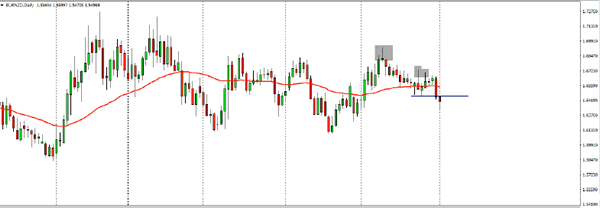
EURNZD Daily Chart – Pepperstone MT4
Let us imagine wanting to short EUR/NZD after seeing a simple shift in structure. Lower Highs pressing against an evident support, which is then broken. The first thing to keep in mind, when managing trades, is:
What is my principal time frame?In this case, it’s the Daily chart. Using our grey matter, since we’re inserting ourselves into a potential longer-term trend, does it make sense to:
* Trade off 5 Minute Charts?
* Scale out after 10 pips and pull stop to par?
* Scalp in the direction of the trend?
* Focus on all day to day market movers?
Evidently, it doesn’t. Your principal time frame of choice (usually the Daily is a good choice) dictates your objectives and the style of trade management that makes most sense. In particular, when playing a daily trend:
* Look to stay seated as long as logically possible
* Ignore any data that is not Tier 1
* Add to the position if & when possible based on your setups
* Pay attention to space covered on a weekly and monthly basis
So now that we have our objective in mind, we can drop down to a 4H or even a 1H chart to look for entries at/around the key level that was broken:
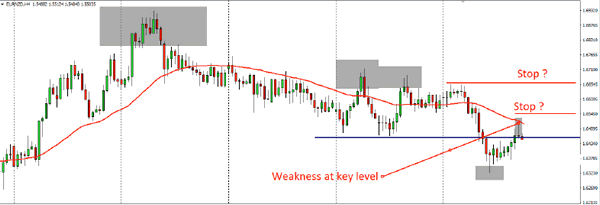
EURNZD 4H Chart – Pepperstone MT4
The market showed weakness upon the retracement to the breakout level. So we can logically take a position short. But where do we put the initial stop loss? We need a stop loss that is congruent with our objectives, and that is logical given the market’s structure, but also gives us decent risk:reward.
One possibility is above the recent swing high that we are shorting from. It is a more aggressive stop loss placement, which may get us kicked out of the market in the event of a double top or rogue spike on a news event. We should be mentally prepared to re-enter the market if that happens, given that our principal chart (Daily) maintains its downward pressure.
A second, more conservative possibility is to go 2 swings up. So we should not suffer from premature stop-outs, but our potential reward is also diluted. So if we consider the first logical target area, (grey rectangle in the chart):
* Entry on break of bearish Pin-Bar @1.6450, stop loss 1.6550 (100 pips), first target 1.6320 (130 pips). So Risk-Reward to 1st potential target is favourable.
* Entry on break of bearish Pin-Bar @1.6450, stop loss 1.6650 (200 pips), first target 1.6320 (130 pips). So risk-reward to 1st potential target isn’t favourable.
(This is just an example, and the first potential target for some traders might also be further down the ladder.)
After the initial entry, in any case, the key is to sit tight until either the target is hit or:
* the stop loss is hit
* the market starts to reverse its course
but in our case, the market continues along its path
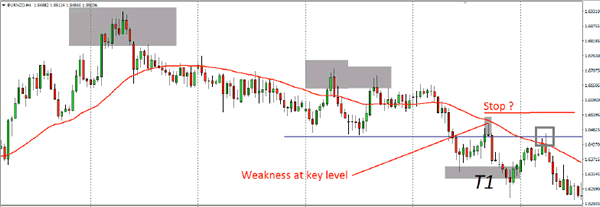
EURNZD 4H chart – Pepperstone MT4
Notice how we cannot move our initial stop loss despite T1 being hit because the market had not produced another lower high for us to trail our stop behind. Only after the next pullback does the market give such an opportunity.
So we can go forth simply staying seated and trailing the stop as the market pulls back and makes new lower swings. So our stop loss will naturally be trailed just above the lower high swings, as the market continues to press lower:
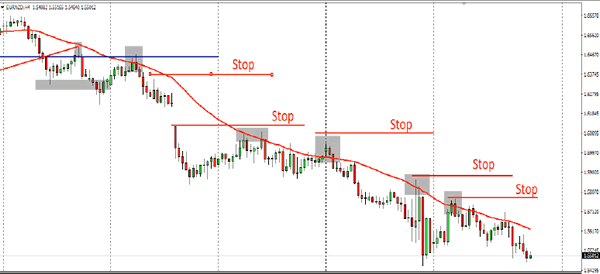
EURNZD 4H chart – Pepperstone MT4
And only in one occasion would we have been watching closely at what price did. When the Daily (principal chart), after printing lower highs and lower lows, printed a higher low.
In a downtrend, when price prints a higher low (which is confirmed after the next day’s close of course), the trend trader needs to pay attention because it’s a loss of trend strength. Price might be turning around, or it may simply be stalling. We will never know ahead of time, so we can only be careful and in cases like these, prepare to pull the plug on our trade.
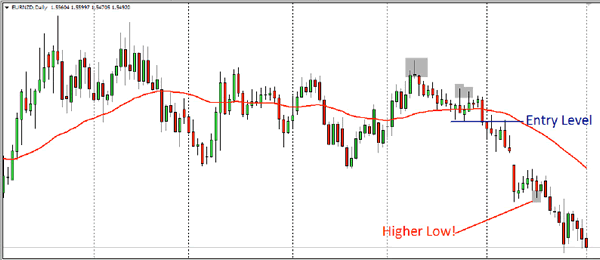
EURNZD Daily Chart – Pepperstone MT4
However, our trailing stop was never triggered and price continued down its path, giving us a trade which we entered for either 100 or 200 pips, and is currently in the black by over 1000 pips (10 R). This result was purely based on our sitting, in pure Livermore style.
Now for another example:
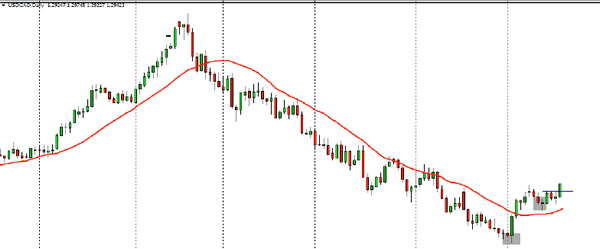
USDCAD Daily Chart – Pepperstone MT4
This time we are still using the Daily chart as our principal chart, and we are buying a potential trend shift upwards. So just like the previous example, let’s dial down onto a 4H chart to position our stop loss and manage our trade.
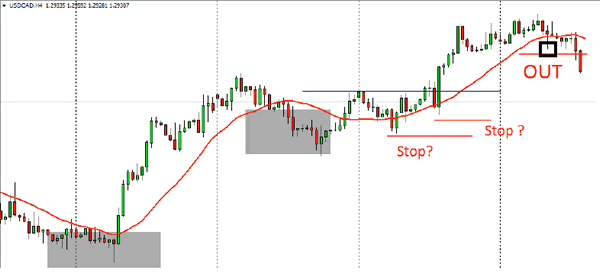
USDCAD 4H chart – Pepperstone MT4
So at the breakout level (1.2960 on May 16th 2016) we have once again a choice of 2 stops. A more conservative option, and a more aggressive option. The key is to be consistent.
If you trade using the aggressive option, then try to trade using the aggressive option as often as possible so your trade statistics can help you understand the pros and cons of it. Same applies if you adopt the more conservative option.
So in our example, the trade progresses swiftly until the most recent swing low is, effectively, violated early in the following week. Now what? Do we start looking for shorts? Absolutely not!
We need to recall our original focus: the Daily Chart. So long as the most recent daily swing low (in an uptrend) or swing high (in a downtrend) holds on any retracement, then we are still able to re-enter the market when the retracement finishes and price starts moving back in line with the trend.
And that’s exactly what happens:
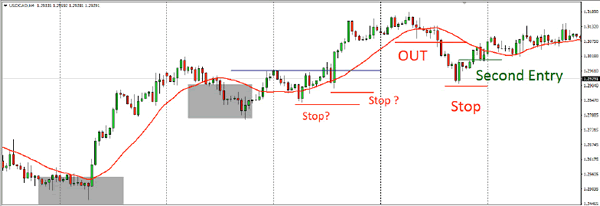
USDCAD 4H Chart – Pepperstone MT4
When the retracement finishes, price starts to find buyers and shifts momentum back in line with our trend. Again, patience often pays off in the markets. Of course, things don’t always go this way.
When to FoldQuite evidently, when we need to scratch our trade is when price does not cooperate well.
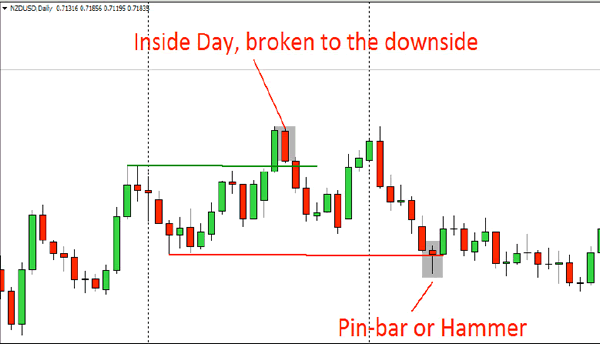
NZDUSD Daily Chart – Pepperstone MT4
Despite the best pre-trade planning, sometimes the market just doesn’t cooperate. Evidence of this is when on the day of entry, or on the very next day, price simply doesn’t go anywhere or it pushes against your entry.
Notice that we are observing price on the same principal time frame. We would not manage our trade based on 4H or 1H price action. We need to be consistent with our principal time frame here.
* When you get an inside day, price is consolidating and in general, it’s best to tighten your stop because from a consolidation, price can go both ways.
* When you get a Hammer or Pin-Bar, it signifies that the market attempted to buck the trend but then fell back with force. Again, it’s time to tighten your stop.
But you don’t need precise price action to tell you something is changing. Think logically: if the move is strong, you will generally have strong closes in line with our trend. It’s only when price starts closing against the trend that you need to start managing your trade and paying attention.